
The United States Asiatic Fleet was a fleet of the United States Navy during much of the first half of the 20th century. Before World War II, the fleet patrolled the Philippine Islands. Much of the fleet was destroyed by the Japanese by February 1942, after which it was dissolved, and the remnants incorporated into the naval component of the South West Pacific Area command, which eventually became the Seventh Fleet.
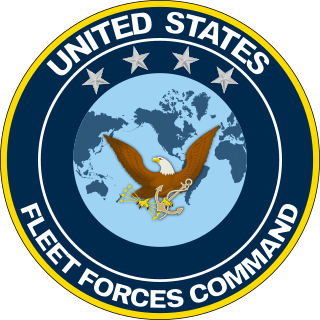
The United States Fleet Forces Command (USFFC) is a service component command of the United States Navy that provides naval forces to a wide variety of U.S. forces. The naval resources may be allocated to Combatant Commanders such as United States Northern Command (USNORTHCOM) under the authority of the Secretary of Defense. Originally formed as United States Atlantic Fleet (USLANTFLT) in 1906, it has been an integral part of the defense of the United States of America since the early 20th century. In 2002, the Fleet comprised over 118,000 Navy and Marine Corps personnel serving on 186 ships and in 1,300 aircraft, with an area of responsibility ranging over most of the Atlantic Ocean from the North Pole to the South Pole, the Caribbean Sea, Gulf of Mexico, and the waters of the Pacific Ocean along the coasts of Central and South America.

Marc Andrew "Pete" Mitscher was a pioneer in naval aviation who became an admiral in the United States Navy, and served as commander of the Fast Carrier Task Force in the Pacific during World War II.

Naval aviation is the application of military air power by navies, whether from warships that embark aircraft, or land bases.

The Imperial Japanese Navy Air Service (IJNAS) was the air arm of the Imperial Japanese Navy (IJN). The organization was responsible for the operation of naval aircraft and the conduct of aerial warfare in the Pacific War.
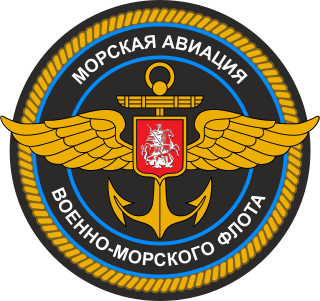
The Russian Naval Aviation is the air arm of the Russian Navy, a successor of Soviet Naval Aviation. The Russian Navy is divided into four fleets and one flotilla: Northern Fleet, Pacific Fleet, Baltic Fleet, Black Sea Fleet, and Caspian Flotilla.
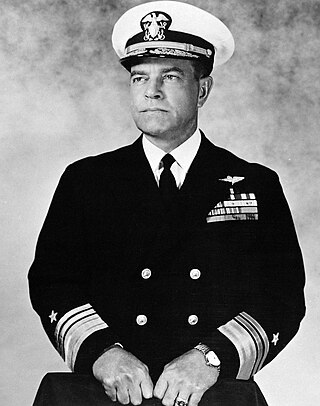
Patrick Nieson Lynch Bellinger CBE was a highly decorated officer in the United States Navy with the rank of Vice Admiral. A Naval aviator and a naval aviation pioneer, he participated in the Trans-Atlantic flight from Newfoundland to Azores in May 1919 and was decorated with Navy Cross, the United States military's second-highest decoration awarded for valor.

Patrol Squadron 46 (VP-46), also known as the "Grey Knights", is a maritime patrol squadron of the United States Navy based at Naval Air Station Whidbey Island, Washington. Part of Patrol and Reconnaissance Wing Ten, VP-46 is the oldest maritime patrol squadron and the second oldest aircraft squadron in the entire U.S. Navy, second only behind VFA-14.

The Commander, Naval Air Force Atlantic is the aviation Type Commander (TYCOM) for the United States Naval aviation units operating primarily in the Atlantic under United States Fleet Forces Command. Type Commanders are in administrative control (ADCON), and in some cases operational control (OPCON) of certain types of assets assigned to the Pacific and Atlantic Fleets. AIRLANT is responsible for the material readiness, administration, training, and inspection of units/squadrons under their command, and for providing operationally ready air squadrons and aircraft carriers to the fleet.

U.S. Navy type commands perform administrative, personnel, and operational training functions in the United States Navy for a "type" of weapon system within a fleet organization.
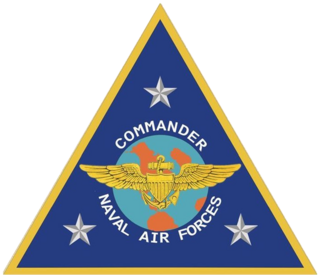
The Commander, Naval Air Forces is the aviation Type Commander (TYCOM) for all United States Navy naval aviation units. Type Commanders are in Administrative Control (ADCON), and in some cases Operational Control (OPCON) of certain types of assets assigned to the Pacific and Atlantic Fleets. AIRFOR is responsible for the materiel readiness, administration, training, and inspection of units/squadrons under their command, and for providing operationally ready air squadrons and aircraft carriers to the fleet.
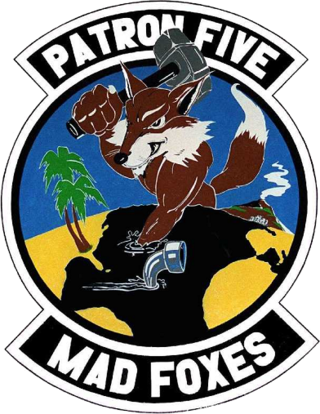
Patrol Squadron FIVE (VP-5) is a long-lived maritime patrol squadron of the United States Navy. It is the second squadron to bear the VP-5 designation. VP-5 is the second oldest patrol squadron, the fourth oldest in the United States Navy, and the 33rd oldest squadron in the United States military. As of 2019, VP-5 is still active and is based at Naval Air Station Jacksonville, Florida.

Charles Perry Mason was a highly decorated officer in the United States Navy with the rank of vice admiral. An early naval aviator, he distinguished himself as commanding officer of aircraft carrier USS Hornet (CV-8), which was sunk during the Battle of the Santa Cruz Islands in late October 1942. Mason was subsequently promoted to rear admiral and served successively as commander, Aircraft, Solomons and chief of the Naval Air Intermediate Training Command at Naval Air Station Pensacola, Florida.

Unmanned Patrol Squadron ONE NINE (VUP-19) is an unmanned patrol squadron of the United States Navy, nicknamed the "Big Red" and established on 1 October 2013.

VP-21 was a Patrol Squadron of the U.S. Navy. The squadron was established as Patrol Squadron 7-B (VP-7B) on 23 July 1929, redesignated Patrol Squadron 7-F (VP-7F) on 1 July 1931, redesignated Patrol Squadron 7 (VP-7) on 1 October 1937, redesignated Patrol Squadron 11 (VP-11) on 1 July 1939, redesignated Patrol Squadron 21 (VP-21) on 1 February 1941 and disestablished on 18 April 1942, with the squadron assets merged with VP-101. It was the third squadron to be designated VP-21, the first VP-21 was redesignated VP-45 on 1 July 1939 and the second VP-21 was redesignated VP-1 on 30 July 1940.

VPB-11 was a Patrol Bombing Squadron of the U.S. Navy. The squadron was established as Torpedo & Bombing Squadron 19-D14 (VT-19D14) on 7 February 1924, redesignated Torpedo & Bombing Squadron 6D14 (VT-6D14) on 1 July 1927, redesignated Patrol Squadron 6-B (VP-6B) on 1 April 1931, redesignated Patrol Squadron 6-F (VP-6F) on 17 July 1933, redesignated Patrol Squadron 6 (VP-6) on 1 October 1937, redesignated Patrol Squadron 23 (VP-23) on 1 July 1939, redesignated Patrol Squadron 11 (VP-11) on 1 August 1941, redesignated Patrol Bombing Squadron 11 (VPB-11) on 1 October 1944 and disestablished on 20 June 1945.

VPB-43 was a Patrol Bombing Squadron of the U.S. Navy. The squadron was established as Patrol Squadron 43 (VP-43) on 21 July 1941, redesignated Patrol Bombing Squadron 43 (VPB-43) on 1 October 1944 and disestablished on 15 September 1945.
VPB-44 was a Patrol Bombing Squadron of the U.S. Navy. The squadron was established as Patrol Squadron 44 (VP-44) on 3 June 1941, redesignated Patrol Bombing Squadron 44 (VPB-44) on 1 October 1944 and disestablished on 20 June 1945.
















